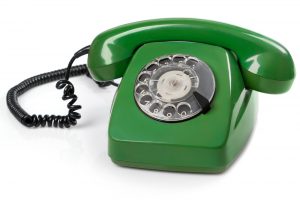Before Google had answers, this team did
Once upon a time, in what feels like a long, long time ago, people had questions. But they didn’t have Google. So, what did we do? How did we make it through the day without instantaneous access to the bajillion facts that are now just a few electronic tap-tap-taps away?
I grew up during this prehistoric information age, so I remember the options. I could’ve looked something up in our set of encyclopedias (as long as the topic didn’t start with the letter S because that volume was always mysteriously absent). I could’ve climbed on my Pink Panther bicycle and ridden to our small town’s library. Or I could’ve asked my parents, who mostly shrugged and told me to go read the encyclopedias they paid good money for.
All those methods took time and effort, which is why random questions often went unanswered in the 70s and 80s. But little did I know, there was another way. Before we had powerful yet petite computers in our back pockets, we had an information task force called The New York Public Library’s Telephone Reference Service – an elite gang of librarians surrounded by books and binders in a room on the second floor of the New York Public Library. They answered the phone (remember when people used to answer phone calls?) and they answered questions.
I learned about these pre-Google gurus last Saturday when I stumbled across a book about them at a used bookstore. Published in 1990, the book is based on 6.2 million questions answered by the Telephone Reference Service during its more than 20-year existence. A gently used copy of “The Book of Answers” (which compiled 1,000 of the team’s most popular, strange, or funny questions) cost me two bucks – a real bargain for such a unique snapshot in time.
When the Telephone Reference Service began in 1968, there was only one person looking up answers to callers’ questions. Over time, the team expanded to 10  people with ninja-level library skills. The team had a few rules. They didn’t answer questions that required a medical or legal opinion, nor did they help with crossword puzzles, kids’ homework, or questions that would take more than five minutes to answer. They also learned the hard way that a question called in by several people in a short period of time was likely because of a radio station’s daily trivia contest, so they didn’t answer those either.
people with ninja-level library skills. The team had a few rules. They didn’t answer questions that required a medical or legal opinion, nor did they help with crossword puzzles, kids’ homework, or questions that would take more than five minutes to answer. They also learned the hard way that a question called in by several people in a short period of time was likely because of a radio station’s daily trivia contest, so they didn’t answer those either.
But most other questions were fair game, and the range of topics was impressive. Here’s a sampling of some of the book’s paraphrased and condensed questions and answers:
What was the first minimum wage? Instituted in 1938, the minimum wage was 25 cents per hour.
Why is the head groomsman at a wedding called the best man? Why isn’t there a best woman? The phrase “best man” is of Scottish origin and recalls the days when a bridegroom simply kidnapped the woman he wanted as his bride. To help him in the task, the groom enlisted friends. The toughest and bravest of the groomsmen was the best man.
What is the longest recorded attack of hiccupping? Sneezing? Yawning? The longest case of hiccups lasted 65 years; the longest sneezing fit lasted 978 days; the longest yawning ordeal took five weeks.
Has anyone ever been hit by a meteorite? At least two people. One of them was Mrs. Hewlett Hodges of Alabama who was hit by a meteorite in 1954 as she napped in her living room. The space rock weighed about 10 pounds.
What language contains the most words? English is the wordiest language, with about 455,000 active words and 700,000 dead words.
That’s all the “active words” I have on these questions. But if you want to know what happened to that woman who got hit by the meteorite while napping, the good news is you can now Google it.
Many thanks to the Telephone Reference Service of the New York Public Library for being the forerunners of modern-day Google, Alexa, Siri, and all the emerging AI chatbots, only more accurate, human, and phone-friendly.
Gwen Rockwood is a syndicated freelance columnist. Email her at gwenrockwood5@gmail.com. Her book is available at Amazon.
